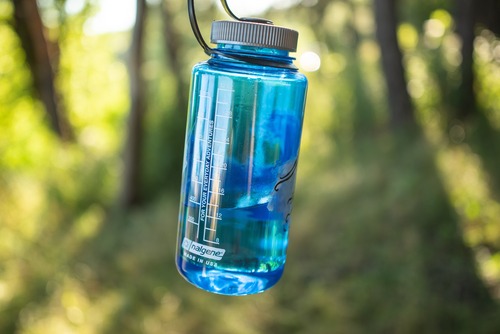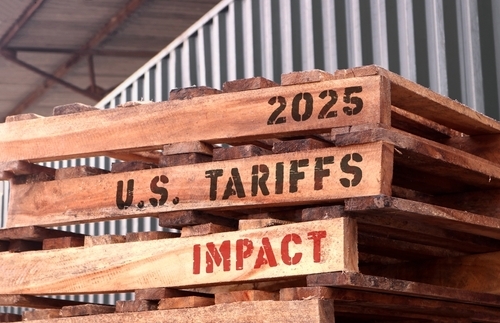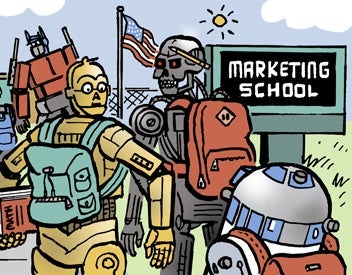Water bottle brand Nalgene may not have the largest marketing budget, but the brand is still growing by relying on its longstanding heritage and scrappy marketing techniques. In this Q&A, Nalgene’s director of marketing Eric Hansen sits down with Multichannel Marketer to talk about its marketing budget, remnant advertising, Amazon ad success and stainless steel competitor Stanley’s impact on the water bottle market.
Nalgene is one of the first reusable water bottle brands, launching in 1949. It is the lone consumer brand within business-to-business science technology company Thermo Fisher Scientific, a $40 billion annual run rate company.
This longstanding heritage has allowed the brand to continue to grow sales in an increasingly crowded water bottle space, said Eric Hansen, Nalgene’s director of marketing.
Hansen recently chatted with Multichannel Marketer about its marketing strategy:
Multichannel Marketer: The water bottle landscape has changed a lot in the past 10 years. How are you guys dealing with that type of competition?
Hansen: Yeah, it’s crazy. It’s changed a couple times in the last couple of decades. One, because of BPA, and then, steel insulated came into the game. But what allows us to constantly remain relevant and on shelf is that we’re a little bit unique. We’re made in USA. And we’re the only plastic brand that hasn’t lost shelf space. If you go back even 10 years, it was like 80% of the shelf space was plastic, 20% was metal. Now that’s more like 50-50. So a lot of that plastic shelf space has gone.
But because of our brand and our history and our credibility, we haven’t really lost that much shelf space. So that’s what allowed us to make it through this big wave of steel insulated. It’s just the fact that we’ve been around forever. We’ve got the credibility. We’re made in USA. And for the most part, outside of a few retailers here and there, we’ve been able to keep our shelf space.
MM: Are you guys still growing?
Hansen: Yep, we grow every year.
MM: How has Stanley specifically impacted you guys?
Hansen: It’s funny, we’ve talked about this for years. The steel insulated bottle — it’s not a one for one, right? You’re not either going to have a stainless steel insulated or a plastic water bottle. The use cases for those is so different. A lot of times we find that somebody who has a Stanley also has a Nalgene bottle. You’re not taking your Stanley to the gym and putting it in the holder. You’re not taking it on a hike; You’re not taking it to soccer. You are taking it to the office, maybe to school. The use cases are different enough that we’re not a one-for-one substitute. I think that’s also part of the reason we’ve been able to hang on the shelf space too, is it’s not an exact substitute for one or the other.
And the other thing too is, especially as it relates to your kids or whoever losing a bottle, you spend 50 bucks on a Yeti or a Stanley or even $60 in some cases, if you lose it, you’re a little less apt to replace it. Whereas if you lose this, this is 15 bucks. That’s another one of the benefits that we’ve had is that steel insulated is just three to four-times the cost of ours that if you lose it, I think people are less apt to buy another one versus ours. If you lose ours, you just buy another one.
MM: Would you guys even consider getting another line of steel insulated bottles because you have that brand credibility?
Hansen: Yeah. We’re looking at insulated too. We’re trying to actually do a plastic insulated, which is a challenge to do just based on chemical properties and product characteristics. It’s kind of tricky, but we are working on that. There’s no doubt there’s a need for the insulated steel. It provides a purpose. It’s good for when you want to keep your beverage hot and cold. It’s definitely something that the consumers value for sure.
MM: Why plastic?
Hansen: Just because that’s who we are. We’re not a steel manufacturer. And the other part is because we are made in USA, none of the steel insulated is done in the U.S. It’s all done overseas.
MM: Can you talk about Nalgene’s marketing efforts on retail media networks, or advertising on retail websites?
Hansen: We don’t really do that on Target. We just haven’t found the value in that yet. But we do do AMS and DPS on Amazon, and we find that to be extraordinary. That might be the most effective digital marketing that we do is on the Amazon platform. It’s very effective. It’s even better than Google AdWords. We get a better ROAS on Amazon than we do on Google. So that’s something that is a big part of our strategy the last couple of years.
MM: Can you walk me through an example for any certain type of product, what do you like to bid on? Which spots on the website?
Hansen: We do spend a lot on ‘Made in USA,’ that’s a big one for us because that’s a massive differentiator with the entire category. The other thing that we do too, which I think I would say all brands do is BPA, BPS free. That’s sort of a big buzzword, especially with moms, and moms and women are making the majority of purchases. So that’s a decision factor that they include as well. Then some of the other stuff we’ll do, we’re a little more outdoor oriented than our brethren in steel. We will do stuff more like best hiking bottle or best bottle for the trail or best bottle for the soccer field, stuff like that, which are areas that we can play a little bit more for us.
MM: Do you do any of the ads on a competitor’s page?
Hansen: We do a little competitive bidding, not a lot. I think if we were a brand like Yeti or Camelback or Contigo, we would probably do that. They’ve got bigger budgets than we do. Again, this is part of the Thermo Fisher conversation that because we’re part of this huge science company that’s B2B, they don’t spend marketing like our competitors do. So our budget relative to our competitors tends to be very limited. We’ve got to be really, really careful on what we choose to spend it on. And competitive bidding is okay, but there’s a bunch of other stuff that we could do that gives us better ROI than that does.
MM: Like the search results page? When the customer intent is there?
Hansen: Exactly.
MM: How do you know your budget is so much smaller than your competitors?
Hansen: From just talking to the other brands that we deal with on a daily basis. And from Kantar. Kantar has good information on what brands are spending. It’s not 100%, but they can see based on what’s happening digitally, they can get about 80 to 85% accuracy as to what brands are spending.
Yeti is the biggest spender in the category. I mean their budgets are just phenomenal. So relative to somebody like Yeti, probably our budget is about a 10th of theirs and then Camelback and some of the others, it’s maybe a fifth of theirs. So we’re definitely much smaller. So that forces us to be super, super effective with all of our marketing dollars.
MM: Would you mind sharing what your ROAS is on Amazon versus Google AdWords?
Hansen: So Amazon, for the year, our ROAS is about 10 bucks. If we do blended, it’s more like $8 because the DSP brings down the ROAS. DSP is Amazon’s version of high level top funnel marketing. So they’ll advertise off Amazon and also higher up before people get to a consumer intent. So yeah, so we’re like $10 on Amazon and on Google we’re probably more like $5 or $6.
MM: So for every dollar you put in, you get $10 out of Amazon?
Hansen: It’s phenomenal. That’s a really good ROAS.
MM: That’s great. Do you guys bid on your own branded terms?
Hansen: Yes.
MM: How do you feel about that? Having to bid on your own?
Hansen: It sucks, but I mean that’s kind of where we’re at, right? With the ecommerce and the digital transformation, you kind of have to.
MM: Why do you have to?
Hansen: Because you got to be in the game, right?
MM: Do you guys have a kind of benchmark that you want to have for any product? Like 60% came from an ad, 40% was organic? Is there kind of a tipping point that’s a good goal for you guys?
Hansen: No, for us it’s still organic is what drives it. Even though we spend money, we still do the best organic. For instance Nalgene.com, still the majority of the traffic comes organically.
Yeah, like I said, we’re a little bit unique. We’ve been around. We just celebrated our 70th birthday. This product actually was spawned from a science product back in the ’50s. We’ve been around a long, long time and we’ve got a long heritage in this category.
In fact, Target came to us 15 years ago to build out their hydration category. They even told us at the time, they came to us because they said, ‘You guys are the O-G. You’re sort of the bottle that created this entire legitimate category.’
And now, whether you walk into a Target or a Dick’s Sporting Goods, it’s just incredible what you see from a hydration perspective. Even 10 years ago, it wasn’t like that. If you go into a Dick’s Sporting Goods, it’s like they’ve got hundreds of feet of wall. It’s all dedicated to hydration vessels. Ten years ago, it was not that way at all.
MM: Your marketing budget for your North American business, how much percent breakdown would you say goes to Google or Amazon and out-of-home and all the other buckets?
Hansen: 90% of our budget’s digital.
MM: And then within digital, what goes to Google, what goes to Amazon, what goes to social?
Hansen: Of those three things, I’d say Amazon will be the biggest social will probably be the second and Google will be third.
We did for the first time this year, we’re trying some out-of-home advertising. We have an ad that runs on the Times Square billboard. It goes every 15 seconds of every hour for the next year. We’ve never really done anything that big. We’re trying to see, and again, that’s more of top-level marketing, just to see if that can move the needle.
MM: I’m surprised because you seem like you guys are cash strapped in marketing. That’s got to be expensive.
Hansen: You know what, it was one of those remnant things. (Sale of unsold advertising space or time slots at a discount.) A strategy of ours, and it’s a little warped, is people will come to us last minute with remnants like, ‘Oh, I have this last little piece. Do you want to do it?’ And you get it many times for dimes on the dollar, and we’ve just gotten so good at this too that we’ll be like, ‘Yeah, that’ll work, but we’ll do it for half of that.’
We got this incredible in-flight EasyJet advertisement in Europe for $2,000. And we saw immediate results on Nalgene. It was totally incredible and we got it for $2,000.
I know it’s kind of weird, but because we are cash strapped, when people call us with remnants, we’ve gotten really good at negotiating that and we’ll get fantastic opportunities that just dimes on the dollar. It is good that we’ve gotten good at that, but it’s bad because you can’t really plan around it. If you were doing planning the right way, you would say, ‘Hey, we’re going to be in Times Square from this to this,’ but we can’t really anticipate that. We don’t know what’s going to be left and what people are going to offer to us. We have to be a little more opportunistic and a little bit more flexible than most. But when it works, it works.
This interview has been edited for length and clarity.

 Network
Network

